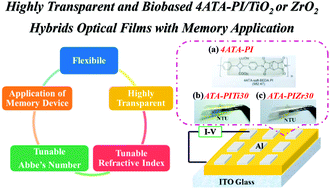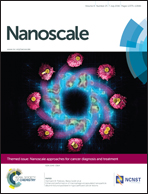Highly transparent and flexible bio-based polyimide/TiO2 and ZrO2 hybrid films with tunable refractive index, Abbe number, and memory properties†
Abstract
The novel bio-based polyimide (4ATA-PI) and the corresponding PI hybrids of TiO2 or ZrO2 with excellent optical properties and thermal stability have been prepared successfully. The highly transparent 4ATA-PI containing carboxylic acid groups in the backbone could provide reaction sites for organic–inorganic bonding to obtain homogeneous hybrid films. These PI hybrid films showed a tunable refractive index (1.60–1.81 for 4ATA-PI/TiO2 and 1.60–1.80 for 4ATA-PI/ZrO2), and the 4ATA-PI/ZrO2 hybrid films revealed a higher optical transparency and Abbe's number than those of the 4ATA-PI/TiO2 system due to a larger band gap of ZrO2. By introducing TiO2 and ZrO2 as the electron acceptor into the 4ATA-PI system, the hybrid materials have a lower LUMO energy level which could facilitate and stabilize the charge transfer complex. Therefore, memory devices derived from these PI hybrid films exhibited tunable memory properties from DRAM, SRAM, to WORM with a different TiO2 or ZrO2 content from 0 wt% to 50 wt% with a high ON/OFF ratio (108). In addition, the different energy levels of TiO2 and ZrO2 revealed specifically unique memory characteristics, implying the potential application of the prepared 4ATA-PI/TiO2 and 4ATA-PI/ZrO2 hybrid films in highly transparent memory devices.


 Please wait while we load your content...
Please wait while we load your content...